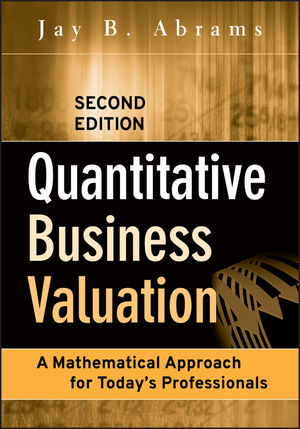Quantitative Business Valuation: A Mathematical Approach for Today's Professionals, 2nd EditionISBN: 978-0-470-39016-0
Hardcover
672 pages
March 2010
 This is a Print-on-Demand title. It will be printed specifically to fill your order. Please allow an additional 10-15 days delivery time. The book is not returnable.
|
||||||
List of Tables and Figures xiii
Introduction xxi
Acknowledgments xxvii
Part I Forecasting Cash Flow 1
Chapter 1 Cash Flow: A Mathematical Derivation 5
Introduction 7
The Mathematical Model 11
Analysis of the Mathematical Model 25
Summary 27
References 27
Chapter 2 Forecasting Cash Flow: Mathematics of the Payout Ratio 29
Introduction 31
The Mathematics 32
Forecasting Gross Cash Flow Is Incorrect 43
Conclusion 44
References 44
Chapter 3 Using Regression Analysis 45
Introduction 47
Forecasting Costs and Expenses 48
Performing Regression Analysis 51
Use of Regression Statistics to Test the Robustness of the Relationship 52
Problems with Regression Analysis for Forecasting Costs 63
Using Regression Analysis to Forecast Sales 64
Autocorrelation in Time Series Analysis 69
Application of Regression Analysis to the Guideline Company (GC) Methods 69
Summary 73
References 74
Appendix 3A The ANOVA Table (Table A3.1, Rows 28–32) 75
Chapter 4 Annuity Discount Factors and the Gordon Model 79
Introduction 81
ADF with End-of-Year Cash Flows 83
Midyear Cash Flows 91
Starting Periods Other Than Year 1 93
Periodic Perpetuity Factors (PPFs): Perpetuities for Periodic Cash Flows 101
ADFs in Loan Mathematics 107
Relationship of the Gordon Model to the Price/Earnings and Price/Sales Ratios 110
The Bias in Annual (versus Monthly) Discounting Is Immaterial 113
Conclusions 119
References 121
Appendix 4A Mathematical Appendix 123
Appendix 4B Mathematical Appendix: Monthly ADFs 141
Part II Calculating Discount Rates 145
Chapter 5 Discount Rates as a Function of Log Size 149
Research Included in the First Edition 151
Table 5.1: Analysis of Historical Stock Returns 152
Application of the Log Size Model 167
Discussion of Models and Size Effects 181
Industry Effects 191
The Wedge between Public and Private Firm Valuations 192
Satisfying Revenue Ruling 59-60 196
Summary and Conclusions 198
References 199
Appendix 5A Automating Iteration Using Newton’s Method 203
Appendix 5B Mathematical Appendix 207
Appendix 5C Abbreviated Review and Use 211
Chapter 6 Arithmetic versus Geometric Means: Empirical Evidence and Theoretical Issues 223
Introduction 225
Theoretical Superiority of the Arithmetic Mean 226
Empirical Evidence of the Superiority of the Arithmetic Mean 227
Indro and Lee Article 232
References 233
Chapter 7 An Iterative Valuation Approach 235
Introduction 237
Equity Valuation Method 237
Invested Capital Approach 243
Log Size 245
Summary 245
References 247
Part III Adjusting for Control and Marketability 249
Chapter 8 Adjusting for Levels of Control and Marketability 253
Introduction 257
The Value of Control and Adjusting for Level of Control 257
Discount for Lack of Marketability (DLOM) 301
Conclusion 358
References 359
Appendix 8A Mathematical Appendix 365
Part IV Putting It All Together 375
Chapter 9 Empirical Testing of Abrams’s Valuation Theory 377
Introduction 379
Table 9.1: Log Size for 1938–1986 380
Table 9.2: Reconciliation to the IBA Database 382
Calculation of DLOM 387
Interpretation of the Error 400
Conclusion 401
References 401
Chapter 10 Measuring Valuation Uncertainty and Error 403
Introduction 405
Measuring Valuation Uncertainty 406
Measuring the Effects of Valuation Error 410
Summary and Conclusions 422
Reference 423
Part V Litigation 425
Chapter 11 Demonstrating Expert Bias 427
Introduction 429
Market Methods 429
A Balanced DCF Valuation 432
Summary 434
Chapter 12 Lost Inventory and Lost Profits Damage Formulas in Litigation 435
Introduction 437
Commentary to Table 12.1: Sample Damage Calculations with VM = $95 438
Table 12.1B: Lost Profits Formulas Based on EBITDA for Lost Sales on Inventory Never Produced 445
When Reality May Vary with Our Assumptions 446
Modification of Formulas for Wholesale and Retail Businesses 447
Legal Treatment 447
Summary 448
Reference 448
Part VI Valuing Esops and Buyouts of Partners and Shareholders 449
Chapter 13 ESOPs: Measuring and Apportioning Dilution 451
Introduction 453
Definitions of Dilution 454
Table 13.1: Calculation of Lifetime ESOP Costs 456
The Direct Approach 457
The Iterative Approach 466
Summary 469
References 474
Appendix 13A Mathematical Appendix 475
Chapter 14 The Trade-off in Selling to an ESOP versus an Outside Buyer 477
Section 1: Introduction 479
Section 2: Advantages and Disadvantages of Selling to an ESOP versus a Third Party 480
Section 3: The Mathematics 481
Section 4: Sample Calculations in the Tables 486
Section 5: Conclusion 494
References 494
Chapter 15 Buyouts of Partners and Shareholders 497
Introduction 499
Table 15.1: Pre- and Post-Transaction Valuations 499
Table 15.2: Dilution in FMV as a Result of the Partner Buyout 501
Sharing the Dilution 503
Conclusion 506
Part VII Probabilistic Methods 507
Chapter 16 Valuing Start-Ups 511
Issues Unique to Start-Ups 513
Organization of the Chapter 513
Part 1: First Chicago Approach 514
Venture Capital Valuation Approach 520
Part 2: Debt Restructuring Study 521
Part 3: Exponentially Declining Sales Growth Model 534
References 536
Chapter 17 Monte Carlo Risk Simulation, by Dr. Johnathan Mun 539
What Is Monte Carlo Risk Simulation? 541
Comparing Simulation with Traditional Analyses 543
Running a Monte Carlo Simulation Using Risk Simulator 543
Using Forecast Charts and Confidence Intervals 554
Tornado and Sensitivity Tools in Simulation 556
Sensitivity Analysis 563
Distributional Fitting: Single Variable and Multiple Variables 567
Getting the Risk Simulator Software 571
Chapter 18 Real Options, by Dr. Johnathan Mun 573
Part 1: Introduction to Real Options 575
Part 2: Traditional Valuation Approaches 585
Part 3: Application: Real Options SLS Software 597
Glossary 617
About the Author 621
Index 623



